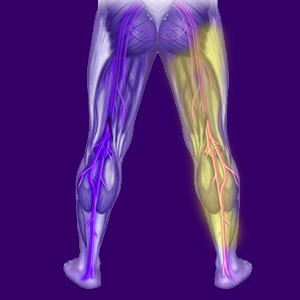
A numb leg is a symptom often associated with various lower back pain and sciatica conditions, but numbness can come from many different causative processes. Numbness comes in 2 varieties, including subjective and objective versions. Additionally, the symptom can affect the patient unilaterally or bilaterally, with each expression adding different dimensions to the diagnostic possibilities.
Numbness anywhere in the body can be very frightening and may occasionally be the sign of a serious medical disorder. This is why proper diagnostic evaluation is of paramount importance for patients who endure chronic numbness in one or both legs.
This treatise examines leg numbness complaints and explores their potential sources. We will detail spinal, nonspinal and non-structural causative processes that might result in subjective or objective numbness in the legs.
Numb Leg with Lower Back Pain
In association with a back pain syndrome, numbness in the leg is statistically most commonly diagnosed as stemming from a compressed nerve root in the lower back. This usually involves the L5 or S1 nerve root being compressed by a herniated disc, osteoarthritis process or other structural abnormality. This condition is often referred to by laymen as a pinched nerve, but the correct medical term is compressive neuropathy.
While it is certainly possible for a pinched nerve to occur, many times the diagnosis is made without verified evidence of a compression syndrome occurring. Furthermore, symptoms often do not match the clinical expectations of the diagnosed condition, yet the verdict stands, nonetheless.
When a pinched nerve is the actual causation, the numbness expressed should be objective and total. This is also very rare, as most numbness complaints are partial and subjective. Additionally, the symptoms should only affect the parts of the leg that are innervated by the compressed nerve structure.
Pinched nerves can rarely be visualized on any type of imaging study, but proper neurological testing can help to pinpoint which, if any, nerves might be affected by a central spinal or foraminal stenotic process.
Numb Leg From Alternate Sources
If leg numbness exists without lower back pain, then the diagnostic possibilities open up to include many other possible causations. Locating the exact source of symptoms can be a time consuming process to be sure. Numbness in the leg or legs can also occur due to many other potential causes, including any or all of the following conditions:
Cervical spinal stenosis or thoracic spinal stenosis can cause weakness and numbness in the legs, as well as the inability to stand or walk. We see obvious severe cervical stenosis as the cause of many leg symptoms, although in some patients, this cause is never even investigated, due to the existence of scapegoat lumbar issues which take the blame, while remaining completely innocent.
Numbness can come from pseudo-sciatica, including piriformis muscle-enacted compression of the sciatic nerve or compression of the nerve by a tumor or cyst.
Leg numbness can be caused by a disease process, a neuromuscular disorder or other systemic cause, although it is rare that numbness will be the exclusive symptom expressed.
Numbness might result from localized nerve tissue injury or disease in part of the leg.
Numbness can come about due to circulatory problems that might affect one or both legs and may be further complicated by specific factors that might relieve or exacerbate the symptomology, such as position of the legs or body.
Finally, numbness might result from mindbody-motivated ischemia. The purposeful reduction in blood and oxygen supply can cause several nasty symptoms, including chronic numbness in one or both legs. The ischemia might target local tissues, but is often directed against the spinal nerve tissues for a more pronounced and variable effect.
Help for a Leg Numbness
Numbness is a symptom that rarely drives patents to seek immediate treatment, since it is not debilitating pain that is being expressed. This is a huge concern, since numbness in the saddle region and legs might be indicators of some of the worst diagnostic possibilities, including extreme cervical central stenosis or cauda equina syndrome. Both of these conditions can become medical emergencies in a very short timeline.
We have seen many of the traditional diagnoses that fully and accurately explain expressed numbness. However, we have also seen many unexpected conditions also create strikingly similar symptom sets. Therefore, we always recommend thorough and comprehensive diagnostic evaluation by a qualified neurologist. We also advise that getting a second opinion is always wise, prior to seeking any treatment for an unverified diagnostic conclusion.
In summary, one of the greatest characteristics of numbness that can assist the diagnostic process is the exact nature of the symptoms themselves. Subjective versus objective numbness can prove very useful during evaluation. Likewise, numbness as a sole symptom, versus numbness in combination with other symptoms, will help to narrow down the field of likely explanations.
As a patient, be sure to fully describe your numb leg symptoms to your diagnostician. As a care provider, always be sure to completely investigate all possible causes before making a determination that might cure the patient if correct, or damn them into following inappropriate treatment protocols if the verdict turns out to be wrong.





